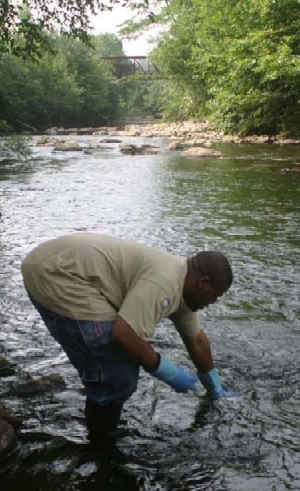 Field
Water sampling at a stormwater influenced river Field
Water sampling at a stormwater influenced river
|
DERIVING RELIABLE POLLUTANT REMOVAL RATES FOR MUNICIPAL STREET SWEEPING AND STORM DRAIN CLEANOUT PROGRAMS IN THE CHESAPEAKE BAY BASIN
Investigators: T.R. Schuler, U. Ghosh, B.E. Reed, C. Welty.
Duration: June 2005 - June 2007.
Funding agency: EPA Chesapeake Bay Program
Background. Despite the fact that street sweeping and storm drain cleanouts rank among the oldest practices used to control storm water pollution, very limited and sometimes conflicting data has been published in regard to their performance in removing nutrients and other pollutants. Despite this uncertainty, many Chesapeake Bay municipalities routinely use one or both practices to comply with their NPDES storm water permits. Sweeping and storm drain cleanouts may be of particular value in reducing pollutants from ultra-urban areas, where few other best management practices are feasible. The Urban Storm Water Work Group of the Chesapeake Bay Program has recognized the importance of defining more accurate pollutant removal rates for these practices as a top priority for its BMP tracking system.
Research Objectives. The objective of this two-year research project is to develop improved estimates of the potential nutrient and sediment reductions achievable through municipal street sweeping and storm drain cleanouts, based on a literature review, a basin-wide municipal survey of existing programs and an intensive field monitoring program within paired catchments located in Watershed 263 in Baltimore, MD.
|